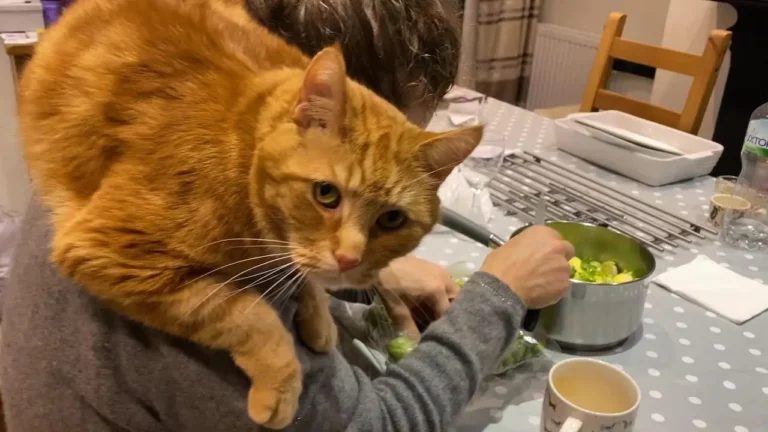5 Reasons to Avoid Punishing Your Cat – And What To Do As An Alternative
Have you ever found yourself at your wit’s end, trying to correct your
Many of us
But here’s a surprising fact: these aversive methods don’t just fail to solve the problem; they can actually make things worse.
Stress isn’t just an unpleasant feeling for our cats—it can lead to serious health issues, including stress-induced cystitis, which is more common than you might think.
In this text, I’ll share insights into why punishing your
Whether your
Everything You should Know To Avoid Punishing Your Cat
It’s crucial to understand that cats are not driven by a desire to please humans – their behaviors are guided by instinct and self-rewarding actions.
Hence, understanding the nuances of
The Ineffectiveness of Punishment
I’ve come to learn that punishment, though it may seem a quick fix for unwanted
Consider a scenario where a
A common reaction might be to yell, spray water, or make loud noises to deter these actions.
But, cats do not connect these punishments with their behavior.
Instead of learning not to scratch or jump, they learn to fear the sound, the water, or worse, the person delivering the punishment.
This fear can lead to stress, which, as I’ve seen, is detrimental to a
Stress in cats can manifest in ways that affect their health, leading to issues like stress-induced cystitis—a condition where cats may experience discomfort and even pain during urination.
The root of the behavior remains unaddressed, and a once cozy relationship can become strained.
Potential for Behavioral Issues
The fallout from punishing cats can extend beyond immediate fear, seeding the potential for long-term behavioral issues.
Cats, unable to connect punishment with their actions, might develop coping mechanisms that manifest as undesired behaviors.
Take, for example, Leo, a client’s
Instead of deterring the initial behavior, the punishment introduced a new problem altogether.
Acknowledging that cats communicate through their actions allows you to adopt an approach centered around providing alternatives and outlets for their natural behavior.
For instance, offering Leo elevated spaces explicitly designed for him to explore satisfied his curiosity and negated the need for counter adventures.
This kind of behavior redirection not only addresses the root cause but also strengthens the bond between
Health Consequences of Stress
The ripple effects of punishment can also breach the area of physical health.
Stress, an all-too-common consequence of fear and anxiety in cats, manifests physically in myriad ways.
From my experience, a
The key takeaway for you needs to be the undeniable link between emotional well-being and physical health in cats, underscoring the importance of a nurturing, stress-free environment.
Positive Reinforcement Is The Way To Go
On the flip side, I’ve observed that positive reinforcement not only works but strengthens the bond between cats and their humans.
Positive reinforcement involves rewarding behaviors we want to encourage, rather than punishing those we don’t.
For instance, if my
This way, the
Incorporating toys, treats, or even verbal praise as soon as the desired behavior occurs is crucial.
Cats live in the moment, so timely rewards ensure they make the correct associations.
An approach I’ve found particularly effective is clicker training, which uses a click sound to mark the exact moment a
This method reinforces good behavior with precision and consistency.
Still, you need to remember every
But, approaching
How to Set Boundaries with Compassion
Setting boundaries with compassion is equally crucial.
Cats are territorial and curious creatures, which means they often wander into areas they shouldn’t.
Instead of shouting or physical removal, I create gentle but firm deterrents.
For example, if a
Cats dislike the sound and feel of foil under their paws, leading them to avoid the area without associating the discomfort with me.
Besides, I make sure to provide appealing alternatives.
If a
I entice her with catnip and hang toys around the post to draw her attention away from the couch.
It’s about channeling their instincts into acceptable behaviors rather than trying to suppress them outright.
Patience and consistency are key, however.
Change doesn’t happen overnight, but with continued effort, I’ve seen remarkable improvements in my cats’ behavior.
Creating a Trustful Environment
Cats, much like humans, thrive in environments where they feel safe and understood.
After adopting my third
This means recognizing their needs for privacy and quiet time and ensuring they have safe spaces, like a cozy
Also, I’ve discovered that simple actions speak volumes.
For example, allowing my
Similarly, responding calmly to unwanted behaviors, like scratching the furniture or jumping on counters, and redirecting his attention to appropriate activities, demonstrated to him that I respect his natural instincts.
Practical tips to enhance this environment include using pheromone diffusers that can help calm anxious cats and ensuring they have enough toys to stimulate their hunting instincts in a constructive way.
Besides, regular, gentle grooming sessions can serve as bonding moments that reinforce trust.
The Importance of Patience and Consistency
Patience and consistency are the bedrock of transitioning any
Misty, a spirited young tabby with a knack for mischief, taught me that lessons in behavior are not learned overnight.
Reflecting a calm and steady demeanor, even when she knocked over my favorite vase, was crucial.
Instead of reacting negatively, I consistently redirected her energy towards toys, rewarding her curiosity without the destruction.
Consistency also means maintaining the same rules and routines, which cats find comforting.
Set feeding times, play sessions, and even quiet times together can help your
A practical tool in applying patience and consistency is a clicker.
Clicker training, reinforced with treats, praises, or playtime, has been instrumental in teaching Bella not to dart out the door.
Start with simple commands and gradually increase complexity, always acknowledging their progress, however small it may seem.
Wrapping This One Up
Exploring the journey of
Let’s continue to build those deep, lasting bonds with our cats, focusing on mutual respect and empathy.
After all, they’re not just pets; they’re family.






